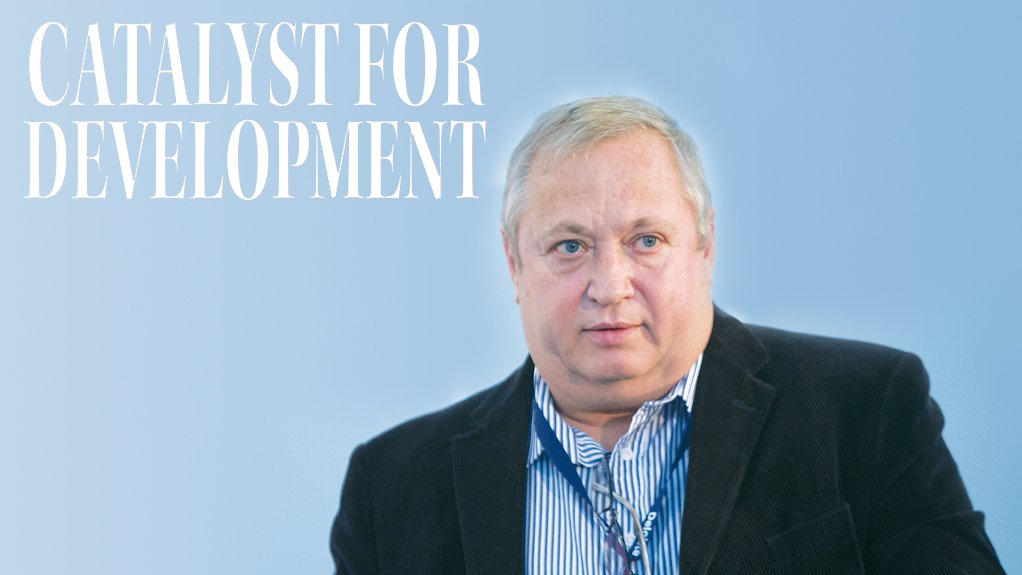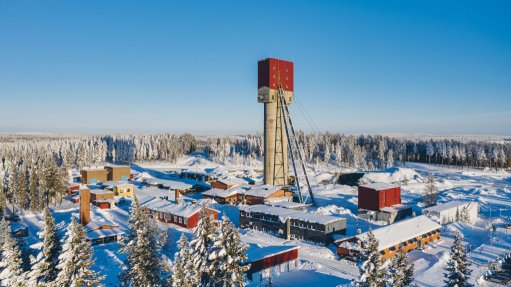Continental vision identifies mining’s role in transforming economies
JOHANNESBURG (miningweekly.com) – The need to diversify Africa’s primary-resource export-focused economies in support of other industry-related value chains is key to helping transform the continent’s economy and generate greater wealth from its significant minerals endowment.
At this year’s Joburg Indaba, which took place earlier this month in Johannesburg, Chamber of Mines of South Africa VP Neal Froneman noted that the African Union (AU) had adopted the Africa Mining Vision (AMV) based on the principle of moving away from minerals extraction to broader development imperatives that integrated minerals policies with economic and socioeconomic development policies.
“What this means in practice is using our country’s vast mineral resources as a catalyst for developments so that it can play a transforma- tive role,” he added.
However, United Nations Economic Commission for Africa (ECA) executive secretary Carlos Lopes points out in an email interview with Mining Weekly that mineral resource exploitation in Africa has not translated into significant and transformative development, owing to factors such as a lack of the requisite skills and resources to support the mining sector. This, in turn, can be attributed to “education and training institutions that are, generally, inadequately resourced to meet the growing demands of the mining sector and address the skills gap”.
Further, he notes that many of the institutions supporting minerals development in Africa are weak. “These include government departments charged with the responsibility of formulating policies, laws and regulations, those tasked with negotiating mineral development agreements, as well as monitoring and regulating the exploitation of mineral resources.”
AU member States adopted the AMV in 2009 to tackle pervasive poverty across Africa, despite its significant minerals wealth, by aligning their various minerals policies with the development of mineral value chains supported by intra-continental trade.
The African Minerals Development Centre (AMDC), based at the ECA, in Addis Ababa, the Ethiopian capital, was launched in 2013 in Maputo, Mozambique, to assist member nations in fast-tracking the alignment of national minerals policies to the AMV.
Froneman emphasised that, to achieve the transformative goals of the AMV, it was important to “build appropriate social and economic development linkages that meet national and regional developmental objectives”.
The AMV points out that such linkages are diverse and involve improving equity and transparency in revenue collection and distribution; integrating small-scale mining into rural economies, thereby improving people’s livelihoods; and linking mineral extraction to infrastructure development and the related manufacture of products that support societal needs.
Froneman highlighted that this required better integration of the mining industry into the development of national, regional and local policies.
The modernised mining industry vision, which was the theme of last year’s Joburg Indaba, was “clearly aligned to the [AMV]”, he stated.
According to Froneman, a modernised mining industry could be achieved only once all mining stakeholders were focused on contributing to the success of the industry rather than “trying to further their . . . self-interests”.
He further asserted that “a modernised mining industry will result in all stakeholders benefiting from the creation of superior value”.
PRIVATE-SECTOR CONTRIBUTION
At a gala dinner held at this year’s Investing in African Mining Indaba, which took place in Cape Town, in February, the Mining Industry Association of Southern Africa (Miasa) held consultations with the AMDC concerning the implementation of the AMV and the proposed AMV Compact.
The compact is a policy aimed at creating an agreement between AU member States and private-sector leaders in the extractive industry to assist with the implementation of the AMV. The draft of the AMV Compact was released in December last year.
In a statement released during the Mining Indaba, Miasa highlighted that it “fully understands and supports the [AMV] as the vehicle for unlocking the full potential of mining in Africa to advance socioeconomic development and fight poverty”, pledging its “unwavering support” for the implementation of the AMV.
However, some Miasa members also expressed concern that the compact might fail to facilitate the smooth implementation of the AMV on account of noncompliant governments and irresponsible companies.
Members described the principles of the compact as “reasonable commitments, subject to some clarification”. Consequently, they requested “further scrutiny and refinement of the document”.
Miasa has also sought the legal counsel of a major corporate mining house, which, it said, had advised that the “AMV Compact should be implemented on a voluntary basis” and not be forced on mining companies.
The association noted that its role would be to mobilise its members and actively participate in the migration of the AMV to country mining visions (CMVs) through cooperation between Miasa members, mining chamber members and the respective Southern African Development Community countries, contributing to the revision of minerals policies and regulatory frameworks at country and, ultimately, regional level.
Miasa comprises the chambers of mines of South Africa, Botswana, the Democratic Republic of Congo (DRC), Madagascar, Namibia, Tanzania, Zambia and Zimbabwe.
AU Trade and Industry commissioner Fatima Haram-Acyl highlights that the AMV offers an Africa-specific approach to shaping the management and role of Africa’s mineral wealth development.
AMDC acting coordinator Kojo Busia elucidates, telling Mining Weekly that participating countries of the AMV have “agreed to develop a knowledge-driven African mining sector that catalyses and contributes to the broad-based growth and development of, and is fully integrated into, one African market through upstream linkages into mining capital goods and downstream linkages into minerals beneficiation, as well as manufacturing and sidestream linkages through infrastructure and power”.
Haram-Acyl adds that the AMV moves away from the conventional single-minded focus on revenue generation by securing the greatest value from mining rents, to a focus that enables countries to “harness broader and more sustainable opportunities and, hence, create, share and distribute value around various forms of linkages”.
Since the adoption of the AMV, a number of countries have received support from the AMDC in developing and aligning their resource policies using its CMV Guidebook, which aims to identify process changes to support sustainable minerals sector reforms.
Haram-Acyl highlights that, in mature mining jurisdictions with well-established minerals policies and regulatory frameworks, such as Ghana, the AMDC, through its CMV process, has provided support in prioritising the promotion of sector links and industrialisation to diversify the economy beyond the minerals sector.
The AMDC has also helped new entrants into the mining industry, such as Malawi, Lesotho and Sierra Leone, to develop “forward looking” mineral resource policies and regulations. Further, the AMDC has supported the adoption of new mining codes in Kenya, Mali and Niger.
“In all these countries, the transformative role and inclusive framework provided by the AMV has widely been credited by stakeholders,” Haram-Acyl asserts.
She notes that, following the adoption of Kenya’s new Mining Act, the country’s Mines Cabinet Secretary, Dan Kazungu, noted that it was the first new mining law in the country in more than 70 years and was formulated with the AMV, Kenya’s Constitution and its Vision 2030 in mind. The Act was signed into law in May this year.
The AMDC provision of support in the development of local-content strategies for Ghana, includes a regional dimension, through studies with actionable recommendations for promoting minerals value chains for the production of critical feedstocks, such as steel, aluminium and cement, to drive industrialisation in the Economic Community of West African States.
AMDC has developed the Geological and Mineral Information System (GMIS) strategy, which aims to improve production and management, as well as the dissemination of geological and mineral information. The GMIS strategy also assists in integrating Africa’s mining sector into broader social and economic development processes.
“For the GMIS, the AMV represents a shift from geological information just for mining development to geological information that supports broad-based sustainable growth and socioeconomic development,” says Haram-Acyl.
The AMDC also assisted the AU Commission in drafting a commodity strategy in accordance with the AMV’s aim of diversifying economies and ensuring structural transformation through the greater value addition of minerals.
Further, the centre has drafted high-level policy reports on harmonising fiscal regimes in Africa’s mineral sector, as well as on illicit financial outflows, with actionable recommendations for closing systemic loopholes that undermine domestic revenue mobilisation along the minerals value chain. Relatedly, the AMDC has supported the globally recognised work of the AU and the ECA High Level Panel on Illicit Financial Flows led by former South African President Thabo Mbeki.
In addition, the AMDC has provided capacity building support for negotiating better minerals contracts that improve revenue generation and, ultimately, enhance broad-based linkages with other sectors. The AMDC has implemented a targeted programme for building capacity in contract negotiations focusing on Chad, the DRC, Equatorial Guinea, Malawi and Niger, Haram-Acyl highlights.
Comments
Press Office
Announcements
What's On
Subscribe to improve your user experience...
Option 1 (equivalent of R125 a month):
Receive a weekly copy of Creamer Media's Engineering News & Mining Weekly magazine
(print copy for those in South Africa and e-magazine for those outside of South Africa)
Receive daily email newsletters
Access to full search results
Access archive of magazine back copies
Access to Projects in Progress
Access to ONE Research Report of your choice in PDF format
Option 2 (equivalent of R375 a month):
All benefits from Option 1
PLUS
Access to Creamer Media's Research Channel Africa for ALL Research Reports, in PDF format, on various industrial and mining sectors
including Electricity; Water; Energy Transition; Hydrogen; Roads, Rail and Ports; Coal; Gold; Platinum; Battery Metals; etc.
Already a subscriber?
Forgotten your password?
Receive weekly copy of Creamer Media's Engineering News & Mining Weekly magazine (print copy for those in South Africa and e-magazine for those outside of South Africa)
➕
Recieve daily email newsletters
➕
Access to full search results
➕
Access archive of magazine back copies
➕
Access to Projects in Progress
➕
Access to ONE Research Report of your choice in PDF format
RESEARCH CHANNEL AFRICA
R4500 (equivalent of R375 a month)
SUBSCRIBEAll benefits from Option 1
➕
Access to Creamer Media's Research Channel Africa for ALL Research Reports on various industrial and mining sectors, in PDF format, including on:
Electricity
➕
Water
➕
Energy Transition
➕
Hydrogen
➕
Roads, Rail and Ports
➕
Coal
➕
Gold
➕
Platinum
➕
Battery Metals
➕
etc.
Receive all benefits from Option 1 or Option 2 delivered to numerous people at your company
➕
Multiple User names and Passwords for simultaneous log-ins
➕
Intranet integration access to all in your organisation





















